Details
A.C. motor Study
-
Torque computation through electrical loading
-
Determination of motor parameters - inertia and friction
-
Digital display of time constant
-
Transfer function evaluation
Introduction
Two phase a.c. servomotor is one of the very important electromechanical actuators having applications in the area of control systems. The study of its operating principle and features form a part of the first course on automatic control systems in electrical engineering curriculum. It’s small size, low inertia and almost noise and frictionless operation makes the a.c. servomotor particularly attractive in aircraft and spacecraft applications.
The characteristics of an a.c. motor is usually non-linear. To simplify the analysis a linearized model is developed. The experimental work revolves around determination of the parameters of the motor and thus its transfer function.
Important subsystems of the unit includes,
(a) an integrated speed sensor with 4-digit display in r.p.m.
(b) an electrical loading system to compute torque
(c) a time-constant measurement circuit with 3-digit display in milli seconds
(d) a three step a.c. source with built-in r.m.s. voltmeter, and
(e) a digital voltmeter on the panel for load measurement
The unit has been designed such that expensive equipment like storage CRO is not needed. Also the hassle of direct torque measurement using spring balance etc. is avoided by linearization of the motor characteristics analytically.
Experiments
Features and Specifications
-
2-phase a.c. servomotor - 12V/ 50Hz per phase
-
Small generator for loading
-
4-digit speed display
-
3-digit time constant display
-
3½ digit r.m.s. voltmeter
-
3½ digit d.c. panel meter
-
Voltage regulated internal supplies
-
Detailed literature with sample results
Ordering Details:

